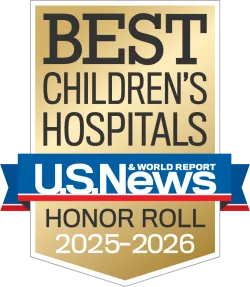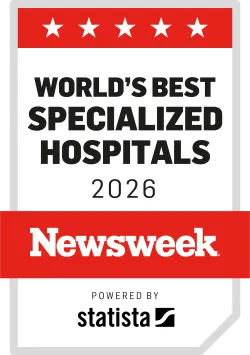Breadcrumb
- Home
- Conditions & Treatments
- LENMELDY
What is LENMELDY and how does it work?
LENMELDY (atidarsagene autotemcel) is a one-time, customized gene therapy for children with metachromatic leukodystrophy (MLD), a rare metabolic disease in which children lack or have too little of an enzyme called ARSA. Without ARSA, the body cannot break down fatty molecules known as sulfatides, which then accumulate in the nervous system. Over time, this causes a regression of behavioral and cognitive function; spasticity and seizures; and problems with vision, moving, talking, and swallowing. About half of children diagnosed with the most aggressive form of MLD face a life expectancy of less than five years.
The first approved treatment option for MLD, LENMELDY is a one-time intravenous (IV) infusion of a child’s own blood-forming stem cells that have been modified to carry a healthy copy of the ARSA gene. The treated cells settle in the bone marrow and supply the body with blood cells, including immune cells that produce the ARSA enzyme. This enables the body to break down sulfatides and may prevent MLD from progressing.
Is my child eligible to receive LENMELDY?
The U.S. Food and Drug Administration approved LENMELDY in 2024 for children with early onset MLD, including:
- Children with late infantile MLD or early juvenile MLD who are not yet showing symptoms (pre-symptomatic)
- Children with early juvenile MLD who are showing only early symptoms of the disease
Late infantile MLD typically begins before 30 months of age, while early juvenile MLD typically begins between 30 months and 7 years of age.
What benefits has LENMELDY shown in studies?
The FDA based its approval on findings from 37 children who received LENMELDY in two open-label clinical trials (meaning all the children knew they were receiving LENMELDY) and through an expanded access program after the trials concluded. They were followed for up to 12 years (median, 6.7 years).
The findings indicate that LENMELDY significantly reduced the risk of severe motor impairment or death compared with children who did not receive the treatment. All LENMELDY-treated children with pre-symptomatic late infantile MLD were alive at 6 years of age, as compared with only 58 percent of children who did not receive LENMELDY. At age 5 years, 71 percent of the treated children were able to walk without assistance, and 85 percent had normal language and performance IQ scores; this has not been reported in untreated children.
Among children with pre-symptomatic or early symptomatic early juvenile MLD, those treated with LENMELDY showed a slowing of motor and/or cognitive impairment.
Is LENMELDY a cure?
It’s too early to know, but our hope is the gene therapy will allow children to make the ARSA enzyme throughout their lives, and that this will prevent MLD from becoming a more serious illness. We are encouraged by the clinical trial results thus far, especially in the pre-symptomatic children with late infantile MLD.
What is the treatment process with LENMELDY?
LENMELDY is custom-made from each child’s own blood stem cells. It involves multiple steps that may take up to nine months to a year to complete.
Stem cell collection and modification
Before LENMELDY treatment, your child will be admitted to the hospital so stem cells can be collected from their blood. Your child will be given medication that will “mobilize” the stem cells out of the bone marrow and into the bloodstream. While your child is under sedation, a special catheter will be placed in a vein to help with collecting the stem cells.The stem cells will be collected from your blood using a process called apheresis. This apheresis process may need to be repeated over four to five days to ensure enough cells are collected. Once it is confirmed that enough stem cells have been collected, the catheter will be removed and your child will be discharged.
The collected stem cells are then edited in a special manufacturing lab to make the custom LENMELDY product. This will take three to four months.
Conditioning treatment and LENMELDY infusion
When the treated stem cells are ready, your child will have several days of testing to make sure they are ready for the treatment. Your child will be admitted to the hospital for four to six weeks. Before receiving LENMELDY, they will receive chemotherapy to eliminate the stem cells with the MLD trait in their bone marrow and make room for the new, treated cells. About a week later, they will receive their treated cells as a one-time intravenous (IV) infusion.
Monitoring and follow-up
After your child’s LENMELDY infusion, they will remain in the hospital while their treated stem cells take hold (engraft) in their bone marrow and start making new blood cells. Our team will watch for and manage any side effects. Once your child returns home, we will schedule regular check-ups to monitor your child’s cognitive and motor function. We recommend annual blood tests for at least 15 years.
Is LENMELDY safe?
The most common side effects of LENMELDY treatment are fever, low white blood cell count, mouth sores, and infections such as respiratory or gastrointestinal infections or infections at the site of catheters. Many of these are caused by the conditioning chemotherapy needed before LENMELDY treatment.
Chemotherapy will temporarily lower your child’s levels of platelets (the cells that make blood clot), white blood cells (which fight infection), and red blood cells. These levels should return to normal once the treated stem cells engraft into your child's bone marrow and begin making new blood cells. Our care team will watch for:
- Abnormal bruising, bad headaches, prolonged bleeding, nosebleeds, bleeding from the gums or in urine or stool, or signs of internal bleeding (such as unusual stomach or back pain) caused by low platelet counts
- Fever, fatigue chills, or infections, which can sometimes be serious, caused by low white-blood-cell counts
The conditioning chemotherapy can also cause painful sores of the lips, mouth, and throat; nausea, vomiting, abdominal pain, or constipation; temporary hair loss; muscle or bone pain; headache; and itching. These symptoms are temporary and our care team can treat them as needed.
While LENMELDY is generally safe, there are some small risks your team will watching closely for:
- Liver damage from veno-occlusive disease (blockage of the veins to the liver). This risk applies to just the first month after treatment.
- Brain inflammation. Alert your care team immediately if your child develops weakness, decreased muscle tone, change in mental status (sleepiness, dizziness, confusion), vomiting, and swallowing difficulties, or seizures.
- Formation of blood clots (thrombosis)
- Blood cancer. Though no cancers have been reported to date with LENMELDY, children should have lifelong monitoring for blood malignancies, which occasionally occur with this type of gene therapy.
Fertility preservation
As in cancer treatment, the conditioning chemotherapy used before LENMELDY treatment may prevent your child from being able to become pregnant or father a child. Your care team will offer referral to our Fertility Preservation Program before the start of treatment. This program provides counseling, sperm banking, egg freezing, and other options for preserving fertility.
Will my health insurance cover LENMELDY?
Because LENMELDY has only recently become available, it’s not yet clear to what extent insurance providers will cover it. We encourage you to talk with your health insurance company and medical team. Boston Children’s Financial Services staff will guide you through the insurance approval process.
Questions?
Contact us:
Gene Therapy Program
Phone: 617-919-1992
Email: gene.therapy@childrens.harvard.edu

